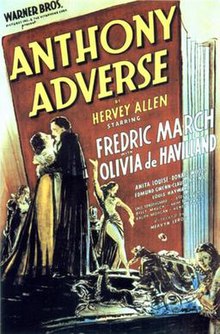
Back أنتوني السيئ (فيلم) Arabic انتونى السيء ARZ Anthony Adverse AST آنتونی ادورس AZB Anthony Adverse Catalan Anthony Adverse Czech Anthony Adverse Welsh Anthony Adverse Danish Ein rastloses Leben German Anthony Adverse Spanish
| Anthony Adverse | |
|---|---|
 Theatrical release poster | |
| Directed by | Mervyn LeRoy |
| Screenplay by | Sheridan Gibney Milton Krims |
| Based on | Anthony Adverse 1933 novel by Hervey Allen |
| Produced by | Hal B. Wallis Jack L. Warner |
| Starring | Fredric March Olivia de Havilland Gale Sondergaard |
| Cinematography | Tony Gaudio |
| Edited by | Ralph Dawson |
| Music by | Erich Wolfgang Korngold |
Production company | |
| Distributed by | Warner Bros. Pictures |
Release dates |
|
Running time | 141 minutes |
| Country | United States |
| Language | English |
| Budget | $1,192,000[2] |
| Box office | $2,750,000[2] |
Anthony Adverse is a 1936 American epic historical drama film directed by Mervyn LeRoy and starring Fredric March and Olivia de Havilland. The screenplay by Sheridan Gibney draws elements of its plot from eight of the nine books in Hervey Allen's 1933 historical novel, Anthony Adverse. Abandoned at a convent as an infant, Anthony comes of age in the tumultuous turn of the 18th to the 19th century, the age of Napoleon. The audience is privy to many truths in Anthony's life, including the tragic story of his origins and the fact that the wealthy merchant who adopts him is his grandfather. Most important of all, Anthony believes that his beloved Angela abandoned him without a word, when in fact she left a note telling him that the theatrical troupe was going to Rome. The gust of wind that blows the note away is one of many fateful and fatal events in Anthony's story.
The film received four Academy Awards, including the inaugural Academy Award for Best Actress in a Supporting Role, given to Gale Sondergaard for her performance as the villainous Faith Paleologus.
- ^ Hanson, Patricia King, ed. (1993). The American Film Institute Catalog of Motion Pictures Produced in the United States: Feature Films, 1931–1940. Berkeley and Los Angeles: University of California Press. p. 70. ISBN 0-520-07908-6.
- ^ a b Warner Bros financial information in The William Shaefer Ledger. See Appendix 1, Historical Journal of Film, Radio and Television, (1995) 15:sup1, 1-31 p 16 DOI: 10.1080/01439689508604551
© MMXXIII Rich X Search. We shall prevail. All rights reserved. Rich X Search